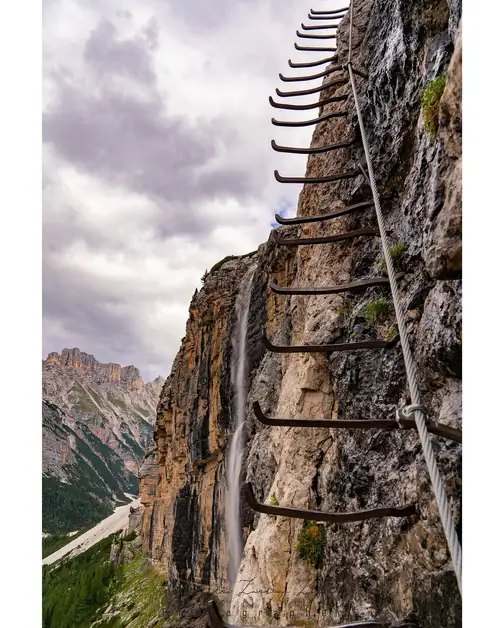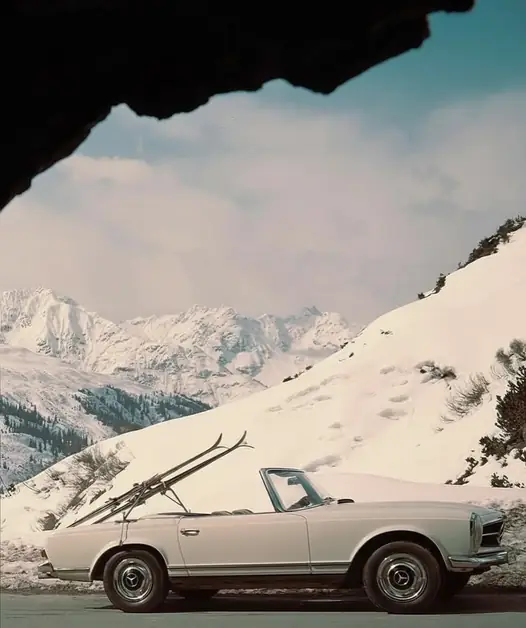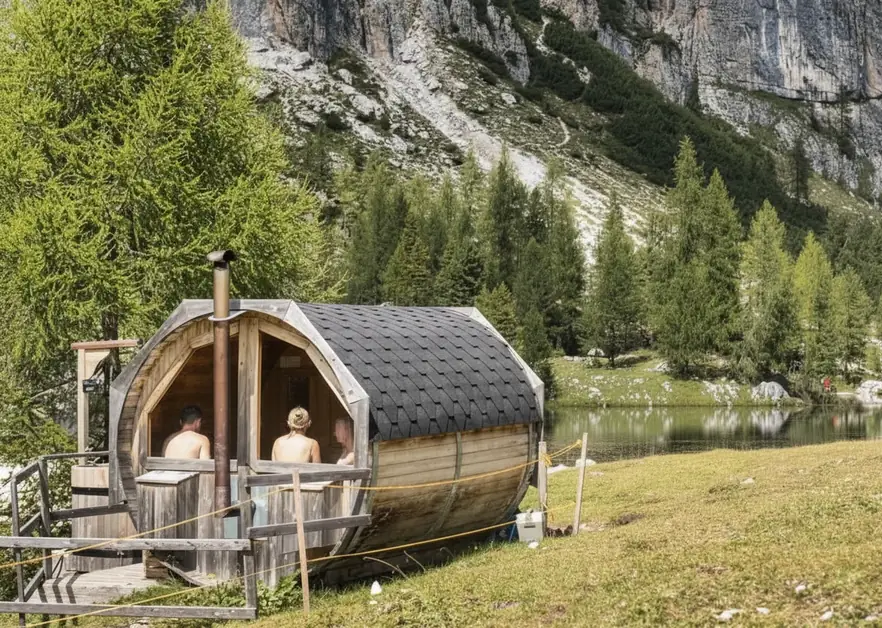The Menighel Ladder between history and adventure
The Menighel Ladder is a historic via ferrata that combines ingenuity and history in the Dolomites.

What is the Menighel Ladder and why is it so important in the history of the Dolomites?
The Menighel Ladder is a historic via ferrata located above Cortina d'Ampezzo, considered the first ferrata built in the Ampezzo area. Its importance derives from the combination of historical, scenic, and cultural value. It is a unique path that combines human ingenuity, the history of the mountain, and the events related to World War I.
Who was Luigi Gilarduzzi known as Minighèl and what role did he play in the creation of the Menighel Ladder?
Luigi Gilarduzzi, known to everyone as Minighèl, was a blacksmith from Ampezzo who managed the Wolf von Glanvell Refuge in Val Travenanzes. He was the one who had the insight to create a faster and safer connection between his refuge and the Giussani Refuge (then called the Cantore Refuge). Thanks to his skill in forging metal, he created the 200 metal rungs that formed the ferrata in 1907.
Why does the Menighel Ladder represent a fundamental stage in the history of via ferratas?
Because it is one of the first examples of a ferrata built with a true practical and logistical intent. It was not a tourist path, but an essential connection for moving in the high mountains. Its construction anticipates by years the construction of the ferratas of the Great War, which then became much more widespread.
What happened to the Wolf von Glanvell Refuge during the Great War?
The refuge managed by Minighèl was located in Val Travenanzes, an area involved in intense fighting. In 1915, the refuge was completely destroyed by Italian artillery. Nothing remains of the structure, but its story survives thanks to the ferrata that Gilarduzzi built.
Why did Minighèl decide to build a ferrata with rungs?
Because that stretch of mountain was very steep. A normal trail would not have been enough, while a metal structure allowed for overcoming rock jumps and difficult slopes. The rungs, forged one by one, ensured stability and safety. Minighèl used his skills as a blacksmith to create a true work of alpine engineering.
How many rungs make up the Menighel Ladder and how were they made?
The original ferrata was composed of about 200 metal rungs embedded in the rock. Each rung was forged in Minighèl's workshop and then manually transported to the area where it would be mounted. The work required great effort and incredible precision.
In what year was the Menighel Ladder built and what was its original purpose?
The ferrata was completed in 1907. Its purpose was to create a direct connection between Val Travenanzes and the Tofana Pass, where the Cantore Refuge (now Giussani Refuge) stands. It was a fundamental passage for moving quickly between the two valleys.
What makes the historical path of the Menighel Ladder unique?
The peculiarity lies in the fusion of ancient craftsmanship and natural context. Walking on the Menighel Ladder means retracing a stretch used over a century ago by climbers, guides, and local inhabitants. It is a true journey through history.
Where is the Menighel Ladder located and how do you reach the starting point?
The itinerary is located in the Tofane area, above Cortina d'Ampezzo, between Val Travenanzes and the Tofana Pass. It is usually reached by climbing up Val Travenanzes or by following the trails that lead to the Giussani Refuge.
What is the difficulty level of the Menighel Ladder today?
It is a ferrata of medium-easy difficulty, suitable for hikers with some experience. The path is short but vertical, and requires the classic ferrata equipment: helmet, harness, and dissipator kit.
What kind of experience can a tourist expect when walking the Menighel Ladder?
An exciting experience immersed in history. You literally walk on a stretch hand-carved into the rock over a century ago. The view of the Dolomites is spectacular and the sense of immersion in nature is total.
Is the Menighel Ladder suitable for families or beginners?
It is recommended for those who have already tried at least one ferrata. The initial verticality can be challenging for those unfamiliar with this type of path. However, with an experienced mountain guide, it can become an accessible experience even for less experienced individuals.
What equipment is essential to safely traverse the Menighel Ladder?
A helmet, harness, ferrata set with dissipator, and gloves are essential. It is also important to wear shoes with good grip and to bring water and appropriate clothing.
What is the best time to walk the Menighel Ladder?
The ideal months are from June to September, when the snow is melted and the path is fully accessible. Avoid days after thunderstorms because the rock can be slippery.
Is the Menighel Ladder open all year round?
No. In winter, the area is snow-covered and the path becomes dangerous. It is recommended to traverse it only in the summer season.
How long does the hike on the Menighel Ladder typically take?
The entire itinerary takes about 3-4 hours, depending on the starting point and the group's pace. The ferrata part itself is quite short, but the hiking context is broader.
What views can be enjoyed while traversing the Menighel Ladder?
From the ferrata, spectacular views of the Tofane massif, Val Travenanzes, and the surrounding Dolomite peaks can be enjoyed. Each step offers a new scenic glimpse.
Are there particular risks that a tourist should be aware of?
As with all via ferratas, it is essential to pay attention to vertical passages, loose rocks, and weather conditions. Good preparation avoids most risks.
Why does the Menighel Ladder continue to fascinate hikers and mountain enthusiasts today?
Because it is a living monument to the history of the Dolomites. It is a testament to the ingenuity, courage, and mountain life of the early 1900s, still perfectly integrated into the alpine landscape.




